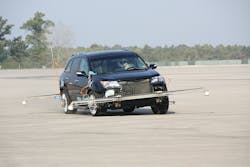Smart-city programs are popping up all over the United States. As we economize the Internet of Things and technology becomes more affordable, cities are taking advantage of the tech boom and looking to instill new programs in their infrastructure. While much of the focus may go to major cities like New York or Los Angeles, medium-sized to smaller cities are actually leading the charge.
A recent survey by the U.S. Conference of Mayors and the analytics firm IHS Markit revealed that 30% of existing smart-city projects are occurring in small cities with residents of 150,000 or less. The survey concluded that smaller and medium-sized cities may have an easier time implementing new technology. These cities may be more motivated to attract interested companies to be their test beds to bringing investment capital and encourage job growth.
One such city is Columbus, Ohio, which was recognized as the Intelligent Community of the Year by the Intelligent Community Foundation. Columbus is the 14th largest city in the U.S. and through public and private sector partnerships, Columbus 2020 was launched to serve “as the economic development organization for the 11-county Columbus Region, working in partnership with state and local partners to generate opportunity and build capacity for economic growth.” The goals which are to be met by the year 2020 are:
- Add 150,000 net new jobs
- Generate $8 billion of capital investment
- Raise personal per capita income by 30%
- Earn recognition as a leader in economic development
The services provided by Columbus 2020 for qualified companies identify programs available for investment and arrange meetings with leaders in the public sector, private sector, academia, and local economic development organizations. The organization also helps with market research, which includes demographic information, workforce analysis and customized data, acquiring land or property for research, and help foreign and domestic companies to increase exports.
The Columbus region is home to a labor force of more than 1million workers and 33% of those workers are graduates with bachelor’s degrees. There are 59 colleges and universities in the Columbus region and in particular, Ohio State University is a main location for innovating applied research for product design, technology commerce, and manufacturing. Its program, the Center for Design and Manufacturing Excellence, works directly with manufacturers to identify and execute growth strategies.
The car above is testing smart mobility protocols at Transportation Research Center Inc. (TRC), the largest independent test facility and proving grounds in North America.
Below are some of the smart city developments that have occurred in the Columbus region through public and private sector partnerships.
- Smart City Challenge Winner: In June 2016, Columbus beat out 77 other cities to win the U.S. Department of Transportation’s (D.O.T.) $40 million Smart City Challenge. The city was awarded $10 million from Vulcan in addition to the funding from the Dept. of Transportation. There was also an additional $500 million pledged by a partnership of public and private entities in the Columbus region, giving the city a total of $550 million to implement its initiatives. The city’s plan is to create an all-inclusive approach using technology to the benefit of all residents, focusing on five major areas: access to jobs, connected visitors, smart logistics, connected citizens, and sustainable transportation.
- Infrastructure Investments: The Columbus region was also awarded $175 million from American Electric Power, $124 million from Honda Motor Co. to build an advanced wind tunnel at the Transportation Research Center in East Liberty, and $15 million from the state of Ohio to develop a Smart Mobility Corridor along US Route 33 between Dublin and East Liberty.
- Ongoing Smart Mobility Efforts:In June, Wind River, an Intel subsidiary, announced that it will partner with the Ohio State University, the Transportation Research Center (TRC), the largest independent test facility and proving grounds in North America, and the city of Dublin, Ohio, where high-speed connectivity is available for its businesses through 125 miles of underground fiber optics, to “advance safe and secure technologies for self-driving and connected vehicle technology.” The partnership is just the latest in a series of efforts being made by the Columbus region to further smart mobility efforts. In August 2017, construction began on US 33 to turn a 35-mile stretch into a “Smart Mobility Corridor,” which will serve as the testing grounds for autonomous and connected vehicles. Underground installation on the 35 miles of high-capacity fiber optic cable is expected to be completed this year. In addition, this year, the TRC received a $45 million grant for new 540-acre SMART (Smart Mobility Advanced Research and Test) Center on the TRC’s campus. Plans for the first phase will set new industry standards, with plans for a 12-lane intersection (the industry’s largest), and a large and flexible test platform (which will be wider than more than 50 highway lanes and the length of 10 football fields), and a range of networks that reflect different environments, including urban, rural and neighborhood networks.
- Strong Ties to the Auto Industry: The Columbus region is home to a robust automotive manufacturing industry, producing 700,000 cars annually. Taking advantage of the TRC, Ohio State’s Center for Automotive Research and College of Engineering, automakers operating in the region benefit from a highly educated workforce of nearly 18,000 working in the automotive industry—nearly four times greater than the U.S. average—and the region’s strategic location within a 10-hour drive to the majority of the U.S. population. The Region is also home to the bulk of Honda’s North American operations; more than one-third of Honda’s North American light vehicle production comes from the Columbus Region. In addition to Honda, the Region boasts a network of suppliers, from G-Tekt to Stanley Electric.
According to Kenny McDonald, certified economic developer and president and chief economic officer of Columbus 2020 since its inception in 2010, the midsize cities are the perfect mix for the development of smart cities. “Metro areas between like one and three million people are big enough to have scale and access to the supply chains of several companies—from Fortune 500 companies and smaller companies—but they are also small enough to where the people know each other at every level and have to work together and be dedicated to accomplish tasks. Organizations like ours are in the middle of it tying all the resources together, from the public sector to the private sector and even to the academic sector together,” says McDonald.
The shape and size of small and mid-size cities make great test beds for smart programs because they are large enough to have the resources but contained enough to be a perfect controlled environment. Hopefully, the success of smaller smart cities can eventually be applied to larger areas and the country. As McDonald notes, “We think of us as this goldilocks theory. You need to be big enough to be able to scale up and small enough that you can actually get something done. We believe in the power of cities and metro areas, and we think that a lot of the responsibility falls upon on us as economic developers to try a build a coalition of smart cities.”

